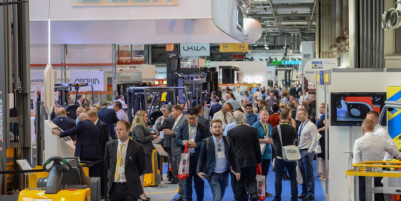-
Nutrivend selects Forterro’s Orderwise to support online expansion and streamline operations - April 11, 2025
-
ARROWXL LAUNCHES AMBITIOUS ZERO WASTE ROADMAP - April 8, 2025
-
THE BCMPA’S NEW CAMPAIGN DRIVES OUTSOURCING SUCCESS IN Q1 - April 7, 2025
-
BLACKOUT TECHNOLOGIES TARGETS TELEMATICS-INTEGRATED MOBILE DEVICE BLOCKING TO COMBAT SMARTPHONE DISTRACTION - April 1, 2025
-
Sparck Technologies awarded Royal designation - March 27, 2025
-
OpenADR Alliance announces first OpenADR 3.0 certified products with EVoke Systems, E.ON Energy and Universal Devices - March 25, 2025
-
Growing fulfilment and contract packer appoints new Managing Director - March 25, 2025
-
When is it time to invest in a WMS? Understanding the key trigger points - March 25, 2025
-
eCapital helps Vantage Recruitment on its journey to financial success - March 24, 2025
-
Hugo Beck Celebrates 70 Years of Packaging Innovation with Open House Events - March 20, 2025
By Louisa Hosegood, Digital and Strategy Director at Bis Henderson Consulting
Faced with mounting challenges on urban congestion, cost pressures and environmental concerns – how should businesses adapt their delivery models to meet rocketing ecommerce order volumes? By Louisa Hosegood, Digital and Strategy Director at Bis Henderson Consulting
Ecommerce has grown massively, and probably permanently, during the pandemic to 30% or more of retail trade. Customers increasingly value the convenience, assurance, immediacy, pricing and safety of ordering online.
The performance of many home delivery operations during the COVID crisis has been truly impressive, ramping up capacity at break-neck speed, running continuously at peak levels, or for some new entrants being truly creative with “emergency models”. However, the traditional ‘last mile’ delivery model – from distribution centre to home addresses, collection points, ‘click and collect’ stores, locker systems and the like – is under huge pressure to serve more customers and greater volumes, and many existing approaches are simply not sustainable in economic, environmental and social terms.
Currently, last mile delivery using IC engine vehicles generates significant CO2 and noxious emissions, and raises many other environmental and social problems, including noise, health issues and congestion – particularly in dense urban areas. With increasingly stringent emissions regulations and planned urban area vehicle restrictions, there is now an urgent need to create a ‘sustainability plan’ for the fast-expanding fleet of vans that is rapidly replacing the old regime of large trucks delivering to stores. And that’s only the vehicle side of final mile, the green agenda extends much wider with the conscious consumer now expecting more in terms of packaging and choices over how and when their parcels are delivered.
The expansion of ecommerce has also placed great demands on physical space, whether it be fulfilment centres or sorting, consolidation and delivery hubs, and this has become a contentious issue. As consumers demand ever faster deliveries, more localised fulfilment models are required. Yet these same consumers, as residents, oppose plans for industrial development in conurbations, as seen by the recent rejection of Ocado’s fulfilment centre expansion in Islington. Many logistics property experts suggest that local government bodies are being slow to realise the mounting urban warehousing challenge heading their way.
What’s more, current models are economically moribund. Consumers expect ‘free’ delivery, but eCommerce is hungry for resources – warehousing, vehicles, order pickers and drivers – which have to be paid for and, as in the case of warehousing and labour, are in short supply. Meanwhile, the push for speed of deliveries means that many delivery trips operate ‘on demand’ and at well below capacity. For omni-channel retailers the switch in emphasis to online sales fundamentally challenges the cost structure of the business, requiring the challenges of ‘final mile’ to be addressed in a more holistic way in order to rebalance costs.
Of course, any comment on ‘last mile’ wouldn’t be complete without mentioning Amazon. Welcome or not, Amazon’s dominance of ecommerce has almost single-handedly upgraded the expectations of every online shopper. This has placed substantial pressure on 3PLs, their delivery partners, and the ecommerce retailers they serve. On the positive side “The Amazon Effect” has helped many retailers realise how critical final mile is to their success.An additional factor, as yet barely addressed, is the need in an eCommerce economy for pick-ups as well as deliveries – not just of returns, but also of consignments from a growing array of micro-businesses and home workers. The recent announcement by Royal Mail that ‘posties’ will also pick up pre-paid packages is an indicator as to how the market is evolving.
Solutions at every scale
To create an economically and environmentally intelligent approach to fulfilment, capable of meeting the needs of consumers, residents and companies, many partial solutions for individual firms are available and more are in development. Let’s consider some key elements of future ‘last mile’ solutions.
An obvious starting point is vehicles. With advances in engineering and creative design, options for delivery vehicles are changing – for example carbon fibre bodies like those being adopted by AO and Asda are much lighter, reducing emissions and increasing payload capacities. Greener fuel options are gaining traction, such as electric and fuel cell technology, and pedal power and pedestrians may be a part of the mix. There may be autonomous delivery ‘robots’, as being trialled in Milton Keynes, and, less probably, drones.
Transport arrangements too will vary. As the market matures it will become evident that not all deliveries need to be same-day and on-demand, allowing for some degree of rationalisation and consolidation. On the other hand, increasingly sophisticated, and affordable, IT systems are becoming available that will further redefine route planning and scheduling, optimising operations in real-time around criteria of time, mileage, emissions or a combination thereof.
Indeed, many of the solutions for last mile delivery will be data driven, and much of the required data already exists or could readily be made available. Dynamic systems can balance options, offering consumers greater visibility and maximum flexibility, such as changing destination at short notice, with greater operational efficiencies of reducing failed or re-deliveries. Systems will provide a platform for greater collaboration by enabling easier consolidation of deliveries from disparate sources for a single destination, creating much needed operational efficiency and, crucially, adding another layer to the coveted customer service proposition.
The network of physical space behind final mile is often forgotten in the race to find cheaper, faster wheels to deliver the parcels. Short leadtimes necessitate close proximity to customers, but finding local warehouse space for sorting and consolidating consignments for last mile deliveries is difficult – even harder than sourcing larger fulfilment facilities. This is where creativity will need to be at its best.
There is considerable scope for automation and IT systems, and simple changes in working practices, to improve the use of resources – labour, space, and energy, in particular.
As High Street footfall diminishes, some stores may become redundant, others may be too large and have “baggy space”, whilst in some in-store order picking may no longer present the same degree of conflict with the ‘shopper-in-person’. In the future, Last mile is likely to involve parcels picked from a variety of locations – from big distribution centres, to shops or former shop premises converted to ‘dark stores’. And that’s even before we consider the concept of urban logistics centres.
The next significant trend, especially for fashion and general merchandise, is inter-retailer collaboration on deliveries, principally to drive down parcel costs, but also to offer consumers a single, timely delivery instead of three or four.
Greater collaboration is the route to creating a more comprehensive urban logistics model. With the right foresight and local authority support, we could see schemes like those popular in Japan, South Korea and Singapore where a multi-storey warehouse with vehicle access at all levels is sited on the periphery of a major conurbation. These facilities could push the boundaries of multi-use to maximise efficient operations by housing a variety of interconnected local area services from ecommerce deliveries, C&C point, shop replenishment or top up, supplier cross dock, inter-store stock rebalancing, returns and collections from customers and returns, and all whilst running a local green fuel multi-vehicle fleet.
This approach works well with a collaborating consortium of up to eight or ten manufacturers or retailers. The environmental and economic benefits of wider collaboration could be considerable, but success depends on a supportive approach from local transport and planning authorities, as is being offered by the Mayor of London and Transport for London.
In the current economic climate, substantial public investment in such comprehensive schemes is unlikely. But there is much that can be achieved by individual businesses and through close collaboration with other organisations and local authorities. Importantly, not every initiative requires significant new money: much can be achieved through intelligent decisions in the normal renewal cycle, and by repurposing existing assets.
Whether you are contemplating something on this scale, or a more modest first move, Bis Henderson can assist you in looking at the ‘last mile’ in the context of your overall logistics solutions, your omni-channel strategies, and the way your physical estate and its utilisation might change. We can advise on designing, procuring and implementing technologies, materials handling and automation, and IT, that will create capacity, drive process improvement and effectiveness, and improve service levels in ‘last mile’ operations. We can also help you benchmark against what your peers are doing, and facilitate collaborations where these make sense.
Critically, we can show you how to make environmentally, socially and economically sustainable ‘last mile’ operations a winning part of your brand.
































